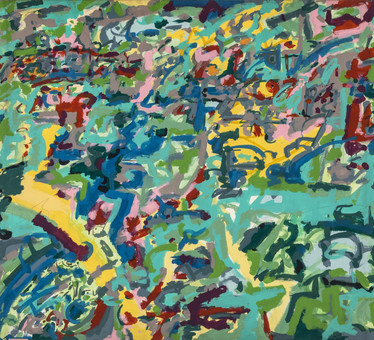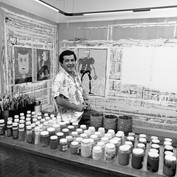Ivald Granato

Campo dos Goytacazes, Brazil, 1949 —
São Paulo, Brazil, 2016
Of what it is possible to be practiced by an artist, very few are those achievements that escaped Ivald Granato. It is not surprising, therefore, that he is one of the precursors of performance in the Brazilian artistic scene. Including his own body, numerous are the supports and means he used in the making of his work, a continuous and intense act of a restless and provocative creation.
Although Granato is known mainly for the practice of performances like I’m not Andy Warhol and Mitos Vadios, it is painting that consecrated most of his artistic production. In it, the artist manages to transmit spontaneity and liveliness, achieved with fast and free brushstrokes, intense and vibrant colors, which results in works of expressive corporeality and frantic creative gesture.
Thus, there are works that dialogue with Pop Art, such as those of the Pop Series, from the 60s, but also the expressive gesture of Gata (1982), in which a hybrid figure of a cat is created combined with the simplified body of a fish surrounded by graphics. In a work like The Still Life that Picasso Painted and Left at My House When I was Five (1979) Granato uses cubism procedures to give a vague anthropomorphic treatment to the abstract, while in Margot (1981) the human figure gets a fanciful and expressive treatment. Granato also experimented with reinterpretations of art history, such as Sem Título / Monalisa, belonging to the 2000s Heads series, in which the artist replaces Monalisa’s face with the silhouette of a head whose features are based on the shape of her father’s head , and also in a work like Baconato (2013), where the artist painted himself on the image of the artist Francis Bacon. In addition, Granato also made inroads into abstraction, as exemplified by the work O Quadro em Frente do Dollar (1983), in which the colors and expressiveness of the brush strokes stand out.
In every pictorial work by Granato, the strength of gesture dominates, the intense presence of the artist’s body in the work. The gesture here operates as evidence of the potent creative act, whose movement and energy are preserved in the finished work, constantly updating the generative process that is painting itself. More than that, it always appears as an event, a paradoxical sign of creation that remains unprecedented even after the consolidation of its own act.
VRP
“To tell the truth, Granato taught me how to paint; how to repaint. He was one of the greatest colorists I've ever seen! The color in his line acquired life and expression” Jose Roberto Aguilar.
“Granato had an understanding that was part of his personality, but at the same time, the relaxation of street people, of the people. His academic residue was just a small veneer. Its expressiveness was very simple, popular” Gilberto Gil
